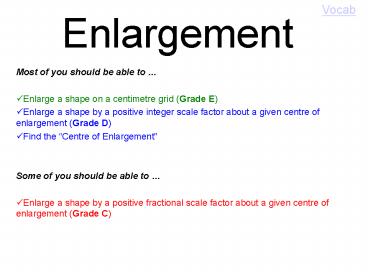Enlargement - PowerPoint PPT Presentation
Title:
Enlargement
Description:
Title: PowerPoint Presentation Author: Mark McCourt Last modified by: Mark McCourt Created Date: 3/16/2004 10:19:52 AM Document presentation format – PowerPoint PPT presentation
Number of Views:124
Avg rating:3.0/5.0
Title: Enlargement
1
Enlargement
Vocab
- Most of you should be able to
- Enlarge a shape on a centimetre grid (Grade E)
- Enlarge a shape by a positive integer scale
factor about a given centre of enlargement (Grade
D) - Find the Centre of Enlargement
- Some of you should be able to
- Enlarge a shape by a positive fractional scale
factor about a given centre of enlargement (Grade
C)
2
Starter Activity 1
Vocab
The lantern throws a shadow across the
floor. What would happen if the lantern was
closer to the man? What would happen if it was
further away?
3
Starter Activity 2
Vocab
What happens to the shadow on the sundial during
the day? Why does this happen?
4
Starter Activity 3
What are the coordinates?
(-4, -2)
(4, 6)
(-1, 1)
(6, 5)
(5, 3)
(4, -2)
(2, -3)
(3, 2)
(7, 1)
(-2, -4)
(-7, 2)
(1, 5)
(-4, 3)
(-2, -1)
5
Vocab
To enlarge a shape on a centimetre grid, simply
multiply the lengths by the scale factor. Hint
You only need to worry about the vertical and
horizontal lengths, the diagonals will follow.
9cm
6cm
6
Vocab
To enlarge a shape about a centre of enlargement,
draw lines from the centre through the vertices.
Scale Factor 3
Now measure along the lines three times the
original distance from the centre of enlargement
to each vertex. This is where the corresponding
vertex will appear. Tip You could use compasses.
7
Vocab
The original vertices should labelled with normal
letters. The corresponding vertices on the image
should be labelled with dashed letters
8
Vocab
What if the CoE is inside the shape?
9
Vocab
What about if I need to find the centre of
enlargement?
We have found the centre of enlargement! (2, 1)
10
Vocab
Plenary
Photographic enlargements. These photographs are
similar rectangles. What is the minimum amount of
information required to be able to fill in all of
the missing lengths and multipliers?
11
Vocab
Further material
Scale Factor -1
12
Web Links
Vocab
- National Library
- Emaths (equivalent ratio Excel file)
13
Back
Transformation A change to a shape carried
out under a specific rule (or set of
rules) Enlargement a transformation in which
lengths of an object are multiplied by the same
amount to produce an image. Scale Factor this
is the value of the multiplier used to enlarge an
object. The multiplier for the area of an shape
is the (Scale Factor)2. The multiplier for the
volume of an shape is (Scale Factor)3. Centre
of Enlargement This is the point from which the
enlargement is projected. Lines joining the
corresponding vertices on the Image and Original
shapes will cross at the centre of
enlargement. Original (or object) the shape
that a transformation is carried out on. The
shape that you start with. Usually labelled with
consecutive letters of the alphabet ABCD
etc. Image - when a transformation is carried
out on an original shape, the shape which appears
is called the image. Usually labelled with dashed
letters ABCD etc, a second image would be
labelled with double dashed letters AB and so
on. Vertex (Pl. Vertices) the corner of an
object. Axis (Pl. Axes) - for two-dimensional
geometry there are two fixed axes, the x-axis and
the y-axis. They cross at right angles and allow
positions to be defined by coordinates. Coordina
te These give the position of a point by
placing it in relation to some other fixed
points, usually the numbers on a set of axes. The
x-axis coordinate is given first. For example,
(2, 3) means the point which is two along the
x-axis and three up the y-axis. Origin the
point where the x-axis and y-axis cross. The
coordinate (0, 0) Similar Shapes are said to
be similar when they are the same in shape but
different in size. One shape is an enlargement of
the other. Corresponding angles are the same
size. Congruent Shapes are said to be
congruent when they are exactly the same.
Corresponding angles are the same size and
corresponding lengths are equal. Ratio This
is used to compare the sizes of two (or more)
quantities. For example, a drink is made by
mixing two parts orange juice with five parts
water. This relationship of 2 to 5 can be written
as the ratio 25.































